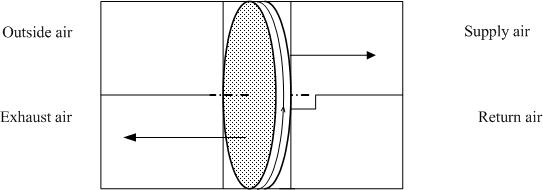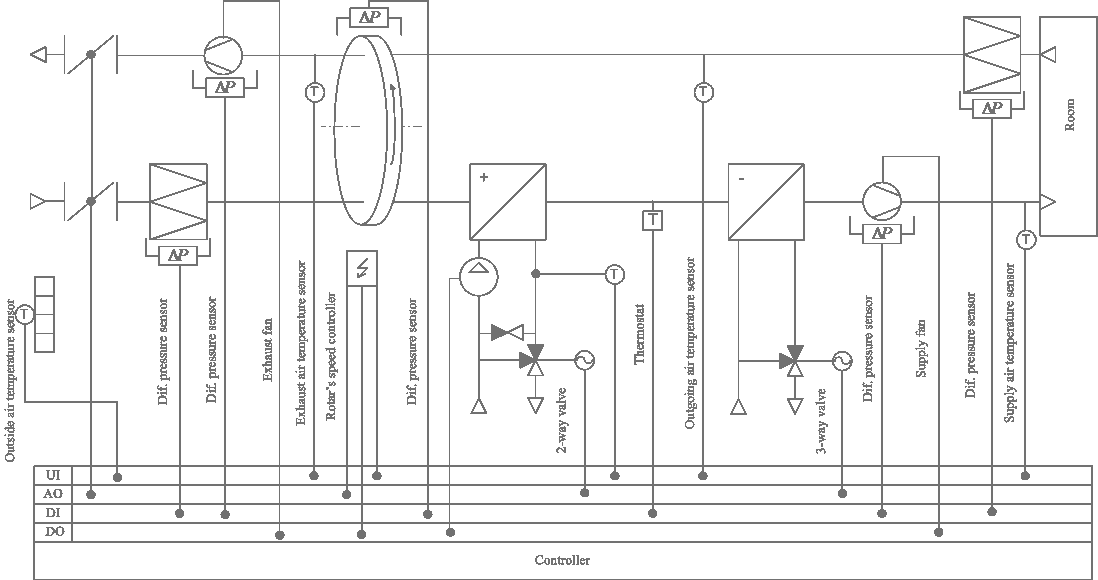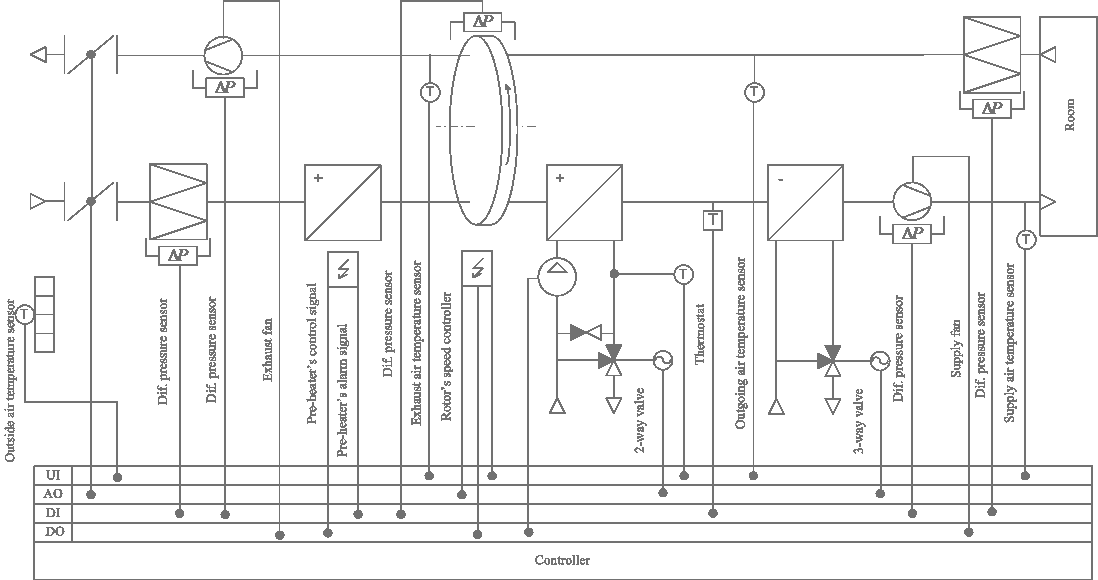Abstract
Contents
- Introduction
- 1. Relevance of the topic
- 2. Tasks of the research, expected results
- 3. Using the methods of heat recovering of ventilation exhausts in heating, ventilation and air conditioning systems
- Conclusion
- References
Introduction
The transition from manual control to an automatical led to the development of automation in the industry. The desire to reduce the human's factor effect and to increase productivity led to a relay-contactor control systems, which were replaced with the first programmable logic controllers and intellectual relays in 1968. Spreading automation in industry has led to a logical using of opportunities to building's engineering equipment's automation. The engineering equipment is a set of technological tools, which creates favorable conditions for people's working and technological process passing in buildings. Using building's engineering equipment's automation systems can improve the safety of the building, can prevent accidents or reduce their aftereffect, can increase efficiency of using the energy, can improve comfort for building's occupants staying that can be achieved only by using complex algorithms and by deep understanding of control objects.
1. Relevance of the topic
The cost of maintenance of buildings begins to play the first part with the commissioning of large shopping and entertainment centers, office buildings, as well as carrying out the reconstruction of libraries, banks, industrial buildings. The task of rationalizing energy's resources consumption becomes urgent in an context of rising tariffs. Using a systematic approach for building automation can minimize energy costs and maintenance of the building in general. Heating, ventilation and air conditioning (HVAC) systems is chosen as an object of researching because of the consuming up to 90% of total energy's consumption in the building.
Master's researching is devoted to the actual problem in the building management systems, ie the search for reserves of reducing power consumption by using electric drive, as well as researching and development HVAC actuator's control algorithms.
2. Tasks of the research, expected results
Main tasks of the research:
- Existing schemes of the central air conditioning analysing.
- HVAC actuator's modes studing.
- Finding thermal resources cost's reducing ways.
- HVAC system's with the heat recovering control algorithm's researching.
Object of the research: HVAC systems
Subject of the research: heat recovering technologies.
Master's researching will receive urgent scientific results in the following areas:
- Development of the mathematical description of energy-saving projects.
- The control algorithm's designing.
3. Using the methods of heat recovering of ventilation exhausts in heating, ventilation and air conditioning systems
To reduce energy consumption in HVAC systems can be used the following methods of heat recovering of ventilation exhausts:
- Using the recirculation of exhaust air;
- Using the recuperative heat exchangers;
- Using regenerative heat exchangers;
- Using two heat exchangers with an intermediate heat transfer fluid.
The method of heat recovering of ventilation exhausts by the regenerative heat exchanger is chosen, as the least studied.
Using regenerative heat exchangers
The regenerative heat exchanger is a waste-heat exchanger of rotary type. The heat exchanging in regenerators is due to blowing a rotating heat exchanger by the supplying and outgoing air (Fig. 1). The efficiency of regeneration depends on the speed – the faster the rotor spins the regenerator, the greater the efficiency of regeneration. However, there is a speed limit, above the which one the efficiency of heat transfering decreases. Typically, this rate is a maximum, usually it's 10-15min‾¹. Typical HVAC system's scheme with a rotary wheel exchanger is shown in Fig. 2. The block diagram has only a part of protections, and can be composed of one or another sensor, air conditioning section, or vice versa.

Figure 1 – The rotary wheel exchanger's schematic diagram

Figure 2 – he HVAC system's with the rotary wheel exchanger block diagram
The rotary wheel exchanger harder to use than recuperative heat exchangers, because it requires additional costs for electricity to rotate the wheel, but electric drive allows to control the heat transfer's performance, which is an advantage over passive recuperators. Also, the benefits to the recuperators include compactness, less metal, less wind resistance, it doesn't need for the continuous removal of condensate. the rotary wheel exchanger can have leakages exhaust air (0.1 ... 2%) into the supply side and vice versa. The anti-freeze protect should be done the similar, as the protect for recuperative heat exchanger. For example, in the Fig. 2; it is represented by a temperature sensor, which installed downstream the rotor in the exhaust air duct. If the exhaust air temperature becomes below 5...10 °C, then drive of the rotor should go to a lower speed, outside air damper should be closed, and the supply fan should be switched off. The heat exchanger blows warm outgoing air by the exhaust fan and thaws. Using the exhaust air temperature sensor is not taken into account the humidity of the outside and exhaust air, so anti-freeze protection may be done with a differential pressure sensor, which is installed on the rotor. Both sensors can be used to improve the reliability of protection. The HVAC systems with the rotary wheel exchanger operating in cold winters are desirable to complete the preheating section, that should be installed upstream the rotor in the supply air duct. (Fig. 3).

Figure 3 – The HVAC system's with the rotary wheel exchanger and pre-heating block diagram
To ensure reliable operation of the equipment, in addition to anti-freeze wheel's protection it is necessary to monitor the thermal state of the fan motors, to control power cirquits and control circuits of fans (using additional auxiliary contacts, relays), to control the temperature of the return water flow of the heater, to monitor of air filters (in Fig. 2 and Fig. 3 offered the option of using a differential pressure sensor). Modern damper actuators and valves have optional analog output to control the position of the actuator, which can be used to monitor the state as well as for diagnostic purposes.
Taking into account the aforesaid it is recommended to reserve additional inputs in controllers to protect the equipment.
There are three major modifications of the rotary wheel exchanger [13 ]:
- Standard. The rotor is divided into 4-6-8-12 sectors. They are used for the sensible energy's regenerating. Standart rotos transfers moisture only in case of the exhaust air temperature is below the dew point temperature. The coiled aluminum matrix is resistant to sea water;
- High temperature. They are used for regenerating sensible energy of the exhaust air temperatures up to +250 °C;
- Enthalpy. Used for the full utilization of the heat, optionally transmits moisture. Entalpy wheels return from the outgoing air to supply air total, ie sensible and latent energy.
Enthalpy rotors are useful HVAC systems with humidity control. In this case it is possible to increase the regenerating efficiency in two or more times [3]. High temperature rotors should be applied in buildings with a large amount of heat. Standart rotors are useful in the remaining cases.
The thermal efficiency of regenerators of the temperature gradient is a function of speed and can reach 80% (Fig. 4). On the basis of the equations of heat balance the the rotary wheel exchanger's model is developed (Fig. 5).

Figure 4 – The function of the efficiency of heat exchange from the rotor speed

Figure 5 – Simple model of the rotary wheel exchanger
In Fig. 5:
η – efficiency of heat transfer, which is a function of speed;
t1 – outside temperature, °C;
t2 – supply air temperature after the regenerator, °C;
t3 – the temperature of the return air, °C;
t4 – the exhaust air emperature, °C;
T – time constant of the heat exchanger (assumed T≈20 s).
To control HVAC system are used specialized hard-coded, zonal and freely programmable logical controllers. Using the last one offers maximum flexibility for writing control algorithms. In case of master's research is used TAC Menta, which is designed to work with specialized, freely programmable controllers TAC Xenta.
The algorithm for controlling the drive of rotary regenerator has been developed during research, which takes into account the mode of winter-summer
, includes working in automatic or manual mode, provides the ability to protect the engine from overheating and protects the rotor from freezing.
Conclusion
Qualitative heating humidity control requires an understanding of the processes occurring in the HVAC systems. The rotary wheel exchanger control algorithm synthesis represents not only theoretical, but practical interest as well.
Master's researching is devoted to the actual problem of reducing the consumption of thermal resources and energy use in buildings. Existing results within the limits of researching:
- A model of the rotary wheel exchanger, which can be used to develop speed control algorithms of the rotary wheel exchanger, and the study of thermal processes in HVAC systems with a constant flow air.
- The requirements for a wheel's drive speed control algorithm have been identified, that is based on the analysis of the literature.
- The nature of the influence of air velocity in ducts to the efficiency of heat transfer has been identified.
- Control methods of mutual cross-flows of air have been established.
Further research focuses on the following aspects:
- Qualitative improvement the rotary wheel exchanger model. Adding the influence of variable flow of air through the rotor.
- Debugging algorithm for rotor's drive speed control.
- Researching other ways of utilization air exhaust.
Master's work hasn't been complete at the moment of writing this abstract. Final completion: December 2012. The full text of the materials on the topic can be obtained from the author or his consultants after that date.
References
- ASHRAE. (1993):"1993 ASHRAE HANDBOOK, FUNDAMENTALS," SI-edition. American Society of Heating, Refrigerating and Air-Conditioning Engineers, Inc., Atlanta.
- ASHRAE. (1992):"1992 ASHRAE HANDBOOK, HVAC Systems and Equipment," SI-edition. American Society of Heating, Refrigerating and Air-Conditioning Engineers, Inc., Atlanta.
- Carnes [Электронный ресурс]. – Режим доступа: http://www.carnes.com.
- Каталог Schneider Electric
Интеллектуальное здание TAC
, 2008 – 174 с. - Бондарь Е.С., Гордиенко А.С., Михайлов В.А, Нимич Г.В. Автоматизация систем вентиляции и кондиционирования воздуха: учебное пособие для студентов высших учебных заведений. – К.: ТОВ Видавничий будинок
Аванпост-Прим
, 2005 – 560 с. - Нимич Г.В., Михайлов В.А, Бондарь Е.С. Современные системы вентиляции и кондиционирования воздуха. – К.: ТОВ Видавничий будинок
Аванпост-Прим
, 2003 – 626 с. - Данилов О.Л., Костюченко П.А. Практическое пособие по выбору и разработке энергосберегающих проектов: в 7 разделах. – ЗАО Технопромстрой, 2006 – 668 с.
- Примеры расчета систем кондиционирования овздуха / Сребницкий Б.Н. – К.: Будівельник, 1970. – 160 с.
- Сотников А.Г. Процессы, аппараты и системы кондиционирования воздуха и вентиляции: в двух томах. Том 2, С.-Петербург,
AT
, 2006. – 416 с. - Сотников А.Г. Процессы, аппараты и системы кондиционирования воздуха и вентиляции: в двух томах. Том 1, С.-Петербург,
AT
, 2006. – 504 с. - Каталог Rosenberg. Модульные установки Airbox. [Электронный ресурс]. – Режим доступа: http://rosenberg-gmbh.com.ua/....
- Википедия. Рекуператор. [Электронный ресурс]. – Режим доступа: http://ru.wikipedia.org/wiki/....
- Форум АВОК [Электронный ресурс]. – Режим доступа: http://forum.abok.ru/....
